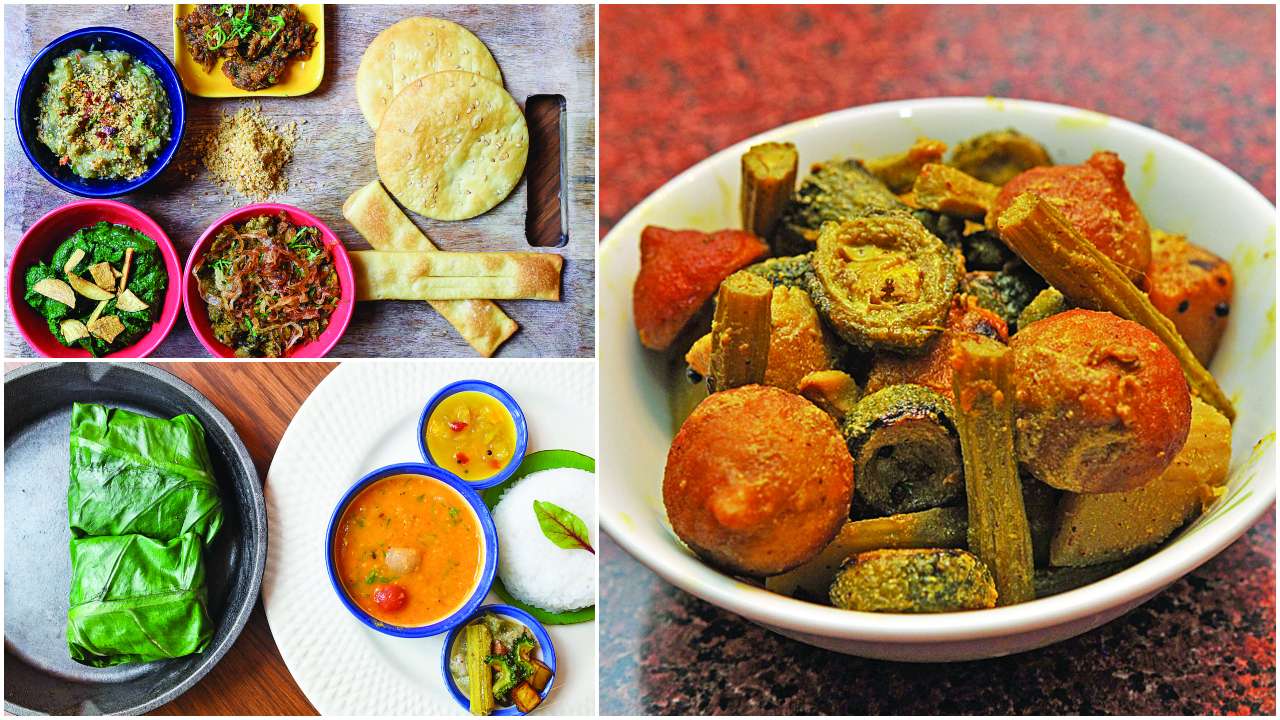
Bengal Ghorowa Niramish Thala (heritage Bengali platter), Taka Luchi aur Dum (cocktail luchi bites), Kaanchkolar Shammi Kabab (green banana kebab)…as I leafed through the menu at Mustard (Mumbai), I was shocked to see as many vegetarian dishes as meat-based ones in their Bengali section. Cuisines come to India and get Indianised, and often, in Mumbai, vegetarianised. I couldn’t help asking Pritha (Sen), the culinary historian and heritage food specialist who has curated this menu, whether that was the case here. But she said, “85 per cent of our repertoire is vegetarian”.
A rich vegetarian repertoire is integral to the dining traditions of the sweet-toothed Ghotis (West Bengalis) as well as the spice-loving Bangals (East Bengalis). “West Bengal only had one river, Hoogly, whereas the East had three, besides a coastline and the largest share of the Sundarbans. Therefore, the East’s produce was far more abundant and varied. But the underlying culture was the same.” On both sides, foraging was big – you could “pluck greens from the pond side and get pumpkins from vines on your roof…”
For the Hindus, apart from availability, Ayurveda was the purveyor of vegetables, as seen in podh, the Bengali course by course way of eating.
“You start with a bitter. As per season it could be karela, neem leaves, parval leaves, helencha, thankuni…all having medicinal properties. Then you progress to a saag – amaranth, spinach, notey, even jute leaves reflecting use of uncultivated foods. Next, dal with fritters. The fourth course is a vegetarian main, generally paanch meshali (a mix of five veggies). Only after this will you proceed to fish curry. On a day paanch meshali isn’t made, the fish curry will have lots of vegetables. In a full meal, white meat follows, then red meat, and then chutney is had as a palate cleanser before dessert.”
The rationale to this progression is that bitters cleanse the body of toxins and excite the juices to ready the body for food and greens provide vitamins and minerals. Also, by the time you come to proteins, you don’t feel like stuffing yourself.
Apart from using vegetables that are seasonal, Bengalis are also “particular about ones to eat in the day and at night. You never have saag at night,” informs Sen.
While Bengal’s aam janta, has long cherished its vegetables, the aristocrats began favouring fish and meat. “The more affluent you get, the more you move away from the food of your roots, using expensive spices and oils to differentiate yourself from the masses. During colonial rule, aristocrats began consuming a lot of rich meats and expensive fish to prove parity with the British,” says Sen.
But it was unavailable to the masses and the cuisine saw a change in complexion. “All these popular dishes – meat and fish of boneless variety like bhetki (barramundi), or potoler dolma (parval stuffed with fish or meat), chingri maacher chiney kebab (jumbo prawns or lobsters stuffed with a rich sauce)…never existed.”
Among Bangals, awareness reduced due to unavailability of several vegetables in their new homeland. “Today, even if available, many won’t recognise them,” says Sen. Societal shift played a role too. Kolkata-based teacher Anjana Dasgupta shares, “Earlier, widows didn’t eat non-vegetarian; that has changed and recipes like mochar ghonto, from banana flower, take a lot of time to make.”
Vegetarian dishes still remain integral in everyday home-food and every part, from root to skin, is used. But due to rise in nuclear families, often with both partners working, “daily, you’ll just have dal, one sabji and anda/fish curry,” says Dasgupta. “Elaborate courses are for Sundays,” adds Sen, whose menu preserves the heritage.
A gradual revival has resulted from blurring of regional differences between Ghotis and Bangals in post-partition years. As the refugees came into their own, acceptance of their cuisine grew too, and due to “demand, both began growing all this stuff. Pumpkin leaves, colocasia leaves and edible flowers are seeing a comeback. Secondly, the youth are attracted to meats, but with age as palates change and people become health conscious, they’re opting for the vegetarian fare,” shares Sen.
In the past three-four years, social media has catalysed the revival with people posting recipes and pictures. “Now if you don’t get tori, you’ll replace it with white zucchini,” Sen signs off.
250gm lauki (peeled and cubed)
1 heaped tbsp black Bengal gram (soaked overnight)
1 cup thin coconut milk
½ cup onion paste
1 heaped tbsp ginger paste
1 tsp chilli powder
2 green cardamoms
2 cloves
1" cinammon
1 bay leaf
2-3 green chillies
1/4th tsp Bengali garam masala powder
1 tsp sugar
3 tbsp refined oil
1/2 tsp ghee
1 slice gondhoraj lime
Salt to taste
Steam lauki cubes till cooked yet firm. Keep aside. Heat oil and temper with garam masala and bay leaf. Add soaked Bengal gram, fry for 2 mins. Add onion paste and fry till translucent. Then add ginger paste and chilli powder, and cook on low heat till all the water evaporates and masalas are well done. Add the steamed lauki cubes, mix well and add coconut milk, salt and sugar. Slow cook to rich consistency. Add ghee and garam masala, green chillies and a twist of gondhoraj lime. Cover and take off fire.